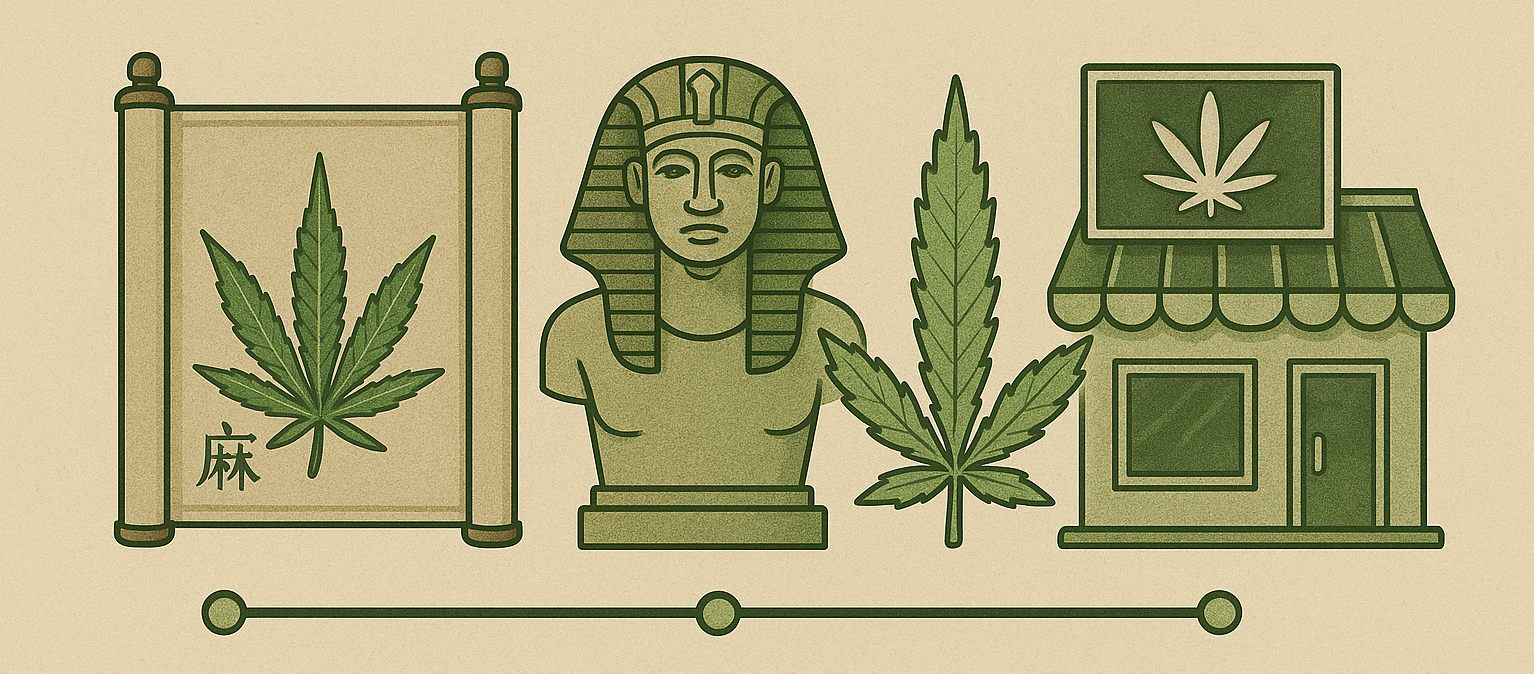The History of Medical Marijuana: A Journey Through 2,700 Years of Healing
From Ancient Remedies to Modern Medicine
Medical marijuana has a storied past, stretching back over 2,700 years across cultures and continents. At Weedcoin, we’re inspired by this rich history as we build a cannabis x web3 movement, and the MediWeed Hub is here to share that journey. In this article, we’ll trace the evolution of medical weed from ancient healing practices to its modern resurgence, exploring key milestones, cultural significance, and the science that has shaped its use today. Let’s travel through time with irie vibes and uncover the roots of medical marijuana!

The earliest recorded use of medical marijuana dates back to around 2800 BC in ancient China, where Emperor Shen Nung, often called the “father of Chinese medicine,” documented cannabis in the Pen Ts’ao Ching, one of the world’s oldest pharmacopeias. Shen Nung described cannabis as a remedy for “female weakness,” rheumatism, malaria, and constipation, noting its ability to relieve pain and inflammation. He reportedly used cannabis in teas and ointments, a practice that became widespread in Chinese medicine. By 1500 BC, the Ebers Papyrus from ancient Egypt mentioned cannabis as a treatment for glaucoma and inflammation, with recipes for cannabis-based salves to reduce eye pressure and soothe wounds, highlighting its early role in medical care.
In India, cannabis took on spiritual and medicinal significance by 1000 BC, becoming a staple in Ayurvedic medicine. Texts like the Sushruta Samhita recommended cannabis for anxiety, insomnia, and digestive disorders, often consumed as bhang, a drink made from cannabis leaves, milk, and spices. Hindu holy men, particularly the Naga sect, used cannabis in rituals to connect with the god Shiva, believing it enhanced meditation and healing. This dual role—medicinal and spiritual—spread cannabis use across the Middle East, where Islamic physicians like Avicenna praised it in the 11th century for treating epilepsy and pain, as documented in his Canon of Medicine.
By the 19th century, cannabis entered Western medicine, largely thanks to Irish physician William Brooke O’Shaughnessy, who studied its use in India during the 1830s. O’Shaughnessy introduced cannabis to Europe, publishing research in 1841 that demonstrated its effectiveness for muscle spasms, migraines, and insomnia. His work led to a boom in cannabis-based medicines, with tinctures and extracts sold in pharmacies across the U.S. and Europe. Queen Victoria reportedly used cannabis to relieve menstrual cramps, prescribed by her physician Sir J. Russell Reynolds, who called it “one of the most valuable medicines we possess.” During this period, cannabis was a standard remedy, often combined with other herbs to treat conditions like neuralgia and gout.
The early 20th century marked a turning point with the rise of prohibition. In the U.S., the 1937 Marihuana Tax Act effectively banned cannabis, driven by political and racial biases rather than scientific evidence. Propaganda campaigns, such as the infamous Reefer Madness film, painted cannabis as a dangerous drug, halting its medical use for decades. Globally, the 1961 UN Single Convention on Narcotic Drugs classified cannabis as a Schedule I substance, further restricting research and access. Despite this, underground use persisted, and by the 1970s, activists began advocating for medical marijuana, citing its benefits for conditions like glaucoma and cancer-related nausea, laying the groundwork for its modern resurgence.
The modern era of medical marijuana began in 1996 when California passed Proposition 215, becoming the first U.S. state to legalize medical cannabis. This law allowed patients with “serious medical conditions” like HIV/AIDS, cancer, and chronic pain to use marijuana with a doctor’s recommendation, sparking a wave of legalization across the U.S. and beyond. Canada followed in 2001 with the Marihuana Medical Access Regulations, and by the 2010s, countries like Germany, Australia, and Uruguay had established medical cannabis programs. The 2020 UN decision to reclassify cannabis, removing it from the most restrictive Schedule IV category, reflected growing global acceptance, driven by research into its benefits for epilepsy, pain, and more.
Today, medical marijuana is recognized in 38 U.S. states, Canada, and numerous countries, supported by a growing body of scientific evidence. Advances in understanding cannabinoids like THC and CBD have fueled its use in treatments like Epidiolex for epilepsy and Sativex for multiple sclerosis spasticity. The history of medical marijuana is a testament to its resilience—a plant that has been revered, banned, and rediscovered, now poised to play a central role in modern medicine. At Weedcoin, we celebrate this legacy as we look to the future, blending cannabis culture with web3 innovation to empower patients worldwide.
Practical Tips
- Learn from History: Explore cannabis’s traditional uses—like bhang for relaxation—to inspire your medical marijuana journey.
- Understand Modern Options: Visit a licensed dispensary to access regulated products, such as CBD oils or THC tinctures, inspired by historical remedies.
- Research Your Region: Check if your area has a medical marijuana program, as legalization varies globally (e.g., legal in Canada, restricted in Japan).
- Choose Heritage Strains: Try landrace strains like Hindu Kush, which have historical roots in traditional medicine, for a cultural connection.
- Stay Informed: Follow global cannabis policy changes, such as UN reclassifications, to understand future access opportunities.
Key Takeaways
- Medical marijuana dates back to 2800 BC, used in ancient China and Egypt for pain, inflammation, and glaucoma.
- In India, cannabis was a spiritual and medicinal tool, used in Ayurveda and Hindu rituals by 1000 BC.
- The 19th century saw cannabis widely prescribed in Western medicine, until prohibition began in the 1930s.
- The modern era started in 1996 with California’s legalization, leading to global acceptance in places like Canada and Germany.
- Today, medical weed is supported by research and policy changes, making it a recognized treatment for various conditions.













